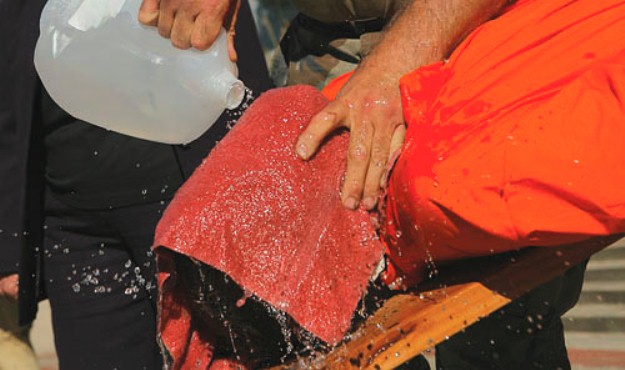The torture report (well, the unclassified executive summary) came out today, and the news is grim and gruesome. The Daily Beast has aggregated some initial lowlights:
In Nov. 2002, a detainee who had been held partially nude and chained to the floor died, apparently from hypothermia. This case appears similar to the that of Gul Rahman, who died of similarly explained causes at a Afghan site known as the “Salt Pit,” also in Nov. 2002. The site was also called ‘The Dark Prison’ by former captives.
The aide said that the Cobalt site was was dark, like a dungeon, and that experts who visited the site said they’d never seen an American prison where people were kept in such conditions. The facility was so dark in some places that guard had to wear head lamps, while other rooms were flooded with bright lights and white noise to disorient detainees.
At the Cobalt facility, the CIA also forced some detainees who had broken feet or legs to stand in stress-inducing positions, despite having earlier pledged that they wouldn’t subject those wounded individuals to treatment that might exacerbate their injuries.
According to the report, there’s no reason to get mired in a “Do the ends justify the means?” question — these brutal tactics were used without improving intelligence gathering. And they weren’t always confined to people who we thought had actionable intelligence at all.
The committee’s report concluded that of the 119 detainees, “at least 26 were wrongfully held.”
“These included an ‘intellectually challenged’ man whose C.I.A. detention was used solely as leverage to get a family member to provide information, two individuals who were intelligence sources for foreign liaison services and were former C.I.A. sources, and two individuals whom the C.I.A. assessed to be connected to Al Qaeda based solely on information fabricated by a C.I.A. detainee subjected to the C.I.A.’s enhanced interrogation techniques,” the report said.
The release of the report is good news at least. We’ve finally hit the “Truth” part of “Truth and Reconciliation” and, in the coming days and months, we have to keep the pressure on to work on the “Reconciliation” part. After Obama conceded “We tortured some folks, I wrote for First Things in August:
Forced by the facts to talk in terms of “torture,” Obama still managed to keep obfuscating the issue in his statement. The specific weasel words change, but the sentiment remains the same. If Obama means to reassure us that torture was a hard, but necessary choice, he still shouldn’t be warning us about the danger of sanctimony.
Sanctimony is what we feel about other folks’ sins – people who are far enough away for us to scoff at. But the abuses that Obama has finally correctly described as torture weren’t committed by anyone far enough away to allow us to feel a Pharisaical pride that we are not like these tax collectors and torturers.
These crimes against international law and human dignity were committed in the last ten years by Americans operating under the protection and direction of our government. We’re hardly discussing the sins of the father being visited on even the first generation, let alone the third and fourth.
If Obama were honest, he’d say, “It’s important for us not to feel too guilty in retrospect about what we did.” In order to deal justly with our abuses, we need to stop pretending we’re debating what will happen to other folks as the result of their crimes. As time passes, we grow guiltier for not making amends, not more and more innocent, as the initial crime fades into the past.
The victims of the abuses we’ve committed aren’t limited to the people who were tortured, though they are certainly the most grave examples. There has been violence done to every person asked to carry out illegal and immoral orders, from the Navy nurse who refused to carry out force-feeding to the CIA interrogators who, according to the report, cried when asked to administer waterboarding and asked to be transferred.
I’m currently reading Jonathan Shay’s Achilles in Vietnam: Combat Trauma and the Undoing of Character, and based on his interviews with veterans, Shay highlights a particular, non-physical wound: betrayal of thémis (right action). From the injustice of Agamemnon’s seizure of Briseis to Vietnam vets’ disgust with being outfitted with known-to-be-unreliable M-16s (to similar supply problems for today’s soldiers), Shay’s interviews and analysis indicate that betrayal of thémis is damaging and destabilizing.
The specific content of the Homeric warriors’ thémis was often quite different from that of American soldiers in Vietnam, but what has not changed in three millennia are violent rage and social withdrawal when deep assumptions of “what’s right” are violated. The vulnerability of the soldier’s moral world has increased in three thousand years because of the vast number and physical distance of people in a position to betray “what’s right” in ways that threaten the survival of soldiers in battle.
The torture report is a chronicle of just such betrayals, drawing soldiers and spies into abuses that insulted the human dignity of both prisoner and captor.
I’m planning to make a $100 donation to the American Civil Liberties Union today, and to match it with a donation to GiveWell’s top-ranked charity: Against Malaria Foundation.













